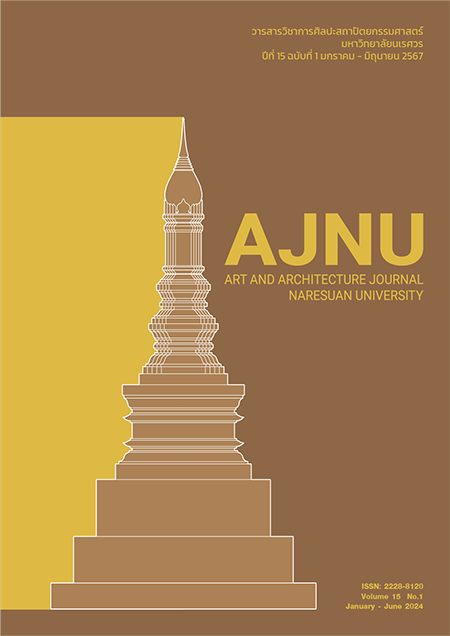Auspicious symbol in Chinese shrine : pattern and belief to creative painting
Main Article Content
Abstract
The objective of the study is to learn the beginning of auspicious symbols in the Shrine Soi dok Mak, study the scheme along with beliefs toward the symbols of the Shrine, and create a painting. The achievement comes from the academic fundamentals of the auspicious symbol research, scheme, and beliefs of the Shrine Soi dok Mak. The tools used for data observation and accumulation have been diffusion theory of culture, semiotic theory, and aesthetic theory; they have been applied to the analysis. The study found that the Shrine of Soi Dok Mak is an old Chinese sacred thing that was once located in the high trading area and the rest area of Chinese merchants. The same area also enshrined the father, or Lord Sam Peel, which is agreeable with diverse versions of the chronicle, including the story of Nang Soi dok Mak, a daughter of the King of China and Honey God. The interior of Shrine Soi Dok Mak has unique fine arts. The use of auspicious symbols is followed by Chinese beliefs. It is considered a channel to give a blessing. The symbol is plain in its appearance, with the form of reduction and also transformation into a new pattern. All crafting techniques are mostly possessed by Chinese, such as floating sculpture, stucco work with low and high relief, lacquered and guilded wood caving, and colorful painting work. After studying the history, patterns, and ideology, the auspicious symbols in Shrine Soi dok Mak become inspiration for fine arts creation through the process of selection of information, sketching, and shape-downsizing of symbols to enhance the beauty of fine arts, pull out their uniqueness, and reflect the contents, concepts, and philosophy of Taoism and Confucianism". The researcher, therefore, presents the creative fine arts under the research topic "Auspicious Symbols in the Chinese Shrine: Pattern and Belief to the Creation of Fine Arts" for 2 pieces.
Article Details

This work is licensed under a Creative Commons Attribution-NonCommercial-NoDerivatives 4.0 International License.
References
กรมศิลปากร. (2534). คำให้การขุนหลวงวัดประดู่ทรงธรรม เอกสารหอหลวง. นนทบุรี : มหาวิทยาลัยสุโขทัยธรรมาธิราช.
เกษียร เตชะพีระ. (2537). แลลอดลายมังกร. กรุงเทพฯ : คบไฟ.
จินตพร จันทร์แต่งผล. (2562). มังกร ศาลเจ้าและความเป็นจีน (เมื่อศาลเจ้าไม่ได้มีแค่เทพเจ้า). กรุงเทพฯ : วารสารสาระดี.
ต้วน ลี่เซิง และคณะ. (2543). ความเป็นมาของวัดจีนและศาลเจ้าจีนในประเทศไทย. กรุงเทพฯ : คณะกรรมการศาสนาเพื่อ
การพัฒนา.
สมบูรณ์ สุขสำราญ. (2530). ความเชื่อทางศาสนาและพิธีกรรมของชุมชนชาวจีน. กรุงเทพฯ : จุฬาลงกรณ์มหาวิทยาลัย.
สุภัทรา โยธินศิริกุล. (2561). สิริมงคลจีนกับความเชื่อตามศาสตร์ฮวงจุ้ยของชาวไทยเชื้อสายจีนในชุมชนเยาวราช. พะเยา
: สาขาภาษาจีน คณะศิลปะศาสตร์มหาวิทยาลัยพะเยา.


